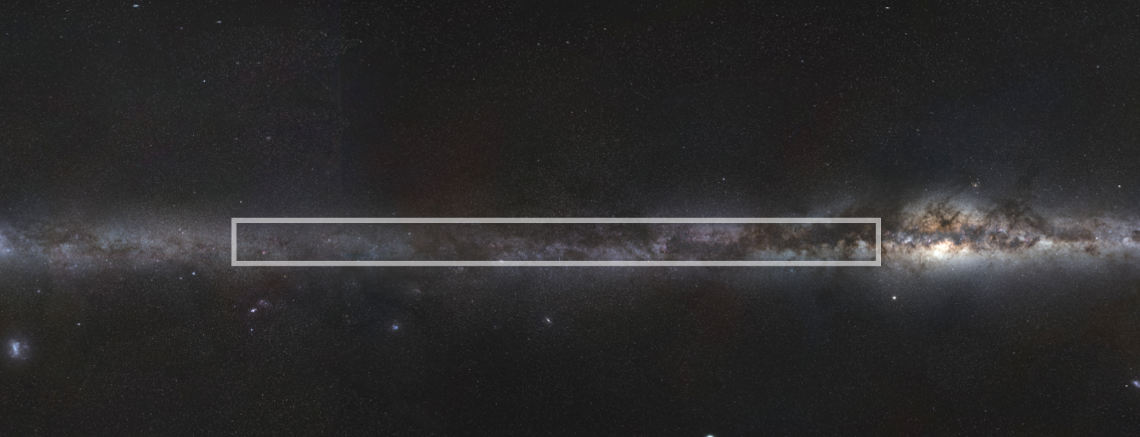
The IGAPS surveys, IPHAS and UVEX, have targeted the northern Galactic disc within the strip contained within the white box, superimposed on the figure above. (Image: ESO/S. Brunier)
IPHAS observing began on the Isaac Newton Telescope (INT) in semester 2003B. By the end of 2008, every IPHAS field had been observed at least once. UVEX got underway in 2006, with data acquisition ending in November 2018.
For IPHAS (r,i,Hα), all Galactic longitudes in the northern Plane within the latitude range -5° < b < 5°, were observed. The complete footprint is just over 1850 square degrees. In the case of UVEX (URGO,g,r), the need to bring observing to a close meant that a small triangle (delimited in RA) was left off the footprint at Galactic longitudes running between 210 and 215 deg, roughly. The INT Wide Field Camera (WFC) offers a pixel scale of 0.33 arcsec per pix, allowing on-sky structures above 1 arcsec in size to be resolved in principle. As sub-arcsecond seeing was not uncommon, there are many images in which this performance is achieved.
At each pointing, sequences of narrow-band Hα, Sloan r and i images (IPHAS) and URGO, g and r (UVEX) were obtained with the INT's Wide Field Camera. The near-simultaneous acquisition of the three bands in each survey means that their characteristic colour-colour diagrams (respectively: r-Hα versus r-i and URGO-g versus g-r) are only minimally affected by source variability.
The Hα filter has a bandwidth of 95 Å and is centred at 6568 Å. For the accompanying broad-band filters we preferred the Sloan filters because of the more nearly rectangular shape of their pass-bands. The survey footprint was covered twice, observing once at each of a set of specified field centres that combine to cover the plane once, and then again at a second set of offset positions. This strategy enhances our quality control and ensures that strips of sky, otherwise falling in the gaps between CCDs, are not left out altogether. The total number of field centres demanded by this strategy was 7635 x 2. The telescope time needed to take data at each field position (plus its offset) and move to the next field centre is approximately 10 minutes.
A significant proportion of all IPHAS data was obtained in bright time. For those fields observed near times of full moon, there is considerable variation of background levels in the images over and above that due to diffuse Hα: this needs to be addressed before the data can be mosaicked successfully. The per-CCD image headers contain information on the median background level. UVEX data were obtained in grey and dark time.
The target seeing limit for data to be counted as meeting survey requirements is 2 arcsec. Some data at worse seeing in lower density fields when the sky transparency was nevertheless good have been used to populate the photometric catalogue. Median seeing in survey-standard data is 1.1 arcsec. Standard star observations are typically obtained every 2-3 hours to facilitate photometric calibration of the survey data. The external, or systematic, errors are in the region of 0.02 magnitudes for g, r and i.
Many people, ranging in status from graduate student to senior professor, contributed to the observing effort over the 15 years it took to collect all the data. The IPHAS and UVEX survey principal investigators, whose job it was to keep resubmitting the observing proposals every year, were respectively Janet Drew and Paul Groot. The data pipeline at the Cambridge Astronomy Survey Unit (CASU) was overseen by Mike Irwin, while the maintenance of the scripts and analysis tools underpinning night-time observing was carried out by Robert Greimel. The lead for the production of the final merged IGAPS catalogue and image set was Maria Monguio. The design of this website owes much to the work of Geert Barentsen.